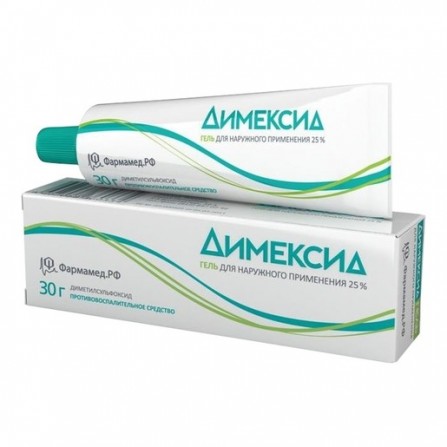Dimexid gel for external use 25% 30g tube
Condition: New product
995 Items
Rating:
Be the first to write a review!

More info
Active ingredients
Dimethyl sulfoxide
Release form
Gel
Composition
Dimethyl sulfoxide 25 g Auxiliary substances: methyl parahydroxybenzoate (nipagin) - 0.05 g, propyl parahydroxybenzoate (nipazol) - 0.013 g, carmellose sodium (sodium carboxymethylcellulose) - 2 g, purified water - up to 100 g
Pharmacological effect
The drug with anti-inflammatory and local analgesic action. It has moderate antiseptic properties and a fibrinolytic effect. Dimethyl sulfoxide inhibits inflammatory tissue infiltration. In addition, dimethyl sulfoxide helps to normalize the processes of fibrin formation, increases microcirculation in tissues, inhibiting the aggregation of red blood cells, increases the activity of phagocytes, suppresses neutrophil chemotaxis and reduces the content of circulating immune complexes. Penetrates through the skin, mucous membranes, the cell wall of bacteria (increases their sensitivity to antibiotics) and other biological membranes, increases their permeability to drugs. The drug has low toxicity.
Pharmacokinetics
Absorption and distribution When the drug is applied, dimethyl sulfoxide is detected in the serum after 8-15 minutes, and Cmax is noted after 2-8 hours. As a rule, after 30-36 hours dimethyl sulfoxide is not detected in the blood serum. When externally used, dimethyl sulfoxide penetrates into the articular cavity, binds to proteins in blood and tissues. Dimethyl sulfoxide does not accumulate. Metabolism and excretion Dimethyl sulfoxide is excreted in the urine unchanged and in the form of oxidation products - dimethyl sulfone and dimethyl sulfate, as well as a reduced product (dimethyl sulfide) is excreted with exhaled air.
Indications
- to relieve pain in the treatment of rheumatoid arthritis, ankylosing spondylitis, osteoarthritis deformans, arthropathy, sciatica, trigeminal neuralgia; - for the treatment of bruises, ligament damage, traumatic infiltrates; - in the treatment of erythema nodosum.
Contraindications
- severe liver damage; - severe kidney damage; - angina pectoris; - myocardial infarction; - pronounced atherosclerosis; - various types of stroke; - glaucoma; - cataract; - coma; - children's age up to 12 years; - pregnancy; - lactation period; - Hypersensitivity to the drug. With caution should be prescribed Dimexid simultaneously with other drugs, due to the fact that it can enhance not only the activity, but also the toxicity of some drugs.
Use during pregnancy and lactation
Use of the drug is contraindicated during pregnancy and lactation.
Dosage and administration
Apply externally. For adults and children over 12 years old, the drug is applied with a thin layer to the affected area 1-2 times / day. Duration of treatment is 10-14 days. Repeated courses may be held not less than 10 days.
Side effects
In the process of using the drug, contact dermatitis, garlic smell of exhaled air, increased skin pigmentation, allergic reactions, erythematous rashes, dry skin, slight burning sensation can be observed. Some patients perceive the smell of the drug badly (nausea, retching), in rare cases bronchospasm is possible.
Overdose
Symptoms: increased dose-related side effects. Treatment: the drug should be canceled, wash the damaged area, remove the drug.
Interaction with other drugs
Compatible with heparin, antibacterial drugs, NSAIDs. Increases the sensitivity of microorganisms to aminoglycoside and beta-lactam antibiotics, chloramphenicol, rifampicin, griseofulvin.
special instructions
Given the possibility of individual intolerance to the drug, it is recommended to carry out a drug test for tolerance to it. To do this, a thin layer of gel is applied to the skin of the elbow bend. The appearance of a sharp redness and itching indicates increased sensitivity to Dimexid. If an allergic reaction occurs during drug treatment, the drug is discontinued, histamine H1 receptor blockers are prescribed.





